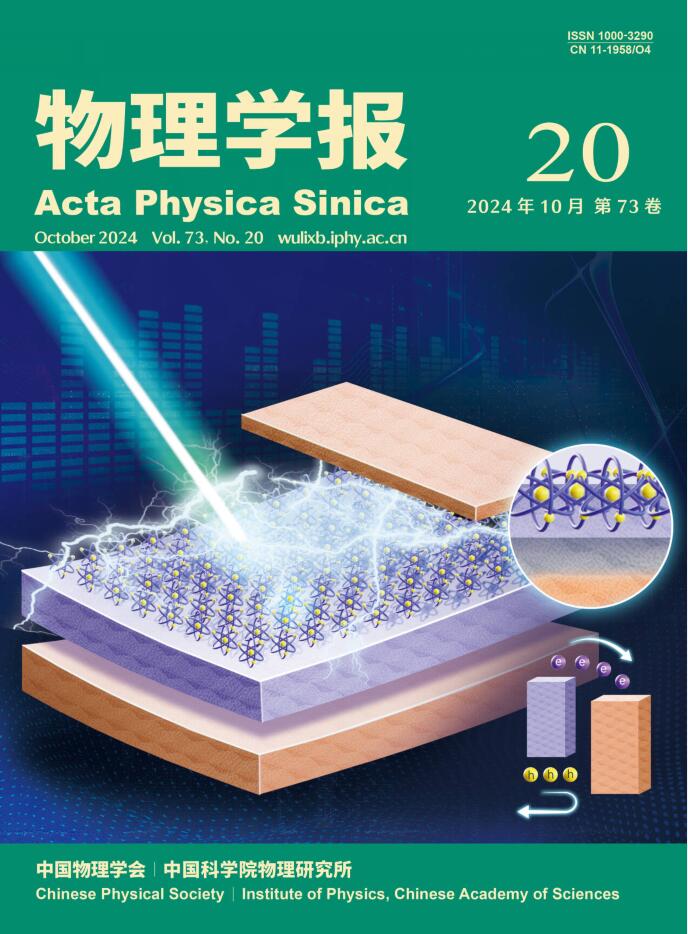Design and fabrication of the superconducting single-photon detector operating at the 5 - 10 micrometer wavelength band
IF 0.8
4区 物理与天体物理
Q3 PHYSICS, MULTIDISCIPLINARY
引用次数: 0
Abstract
High-performance mid-wave and long-wave infrared single-photon detectors not only have significant research value in the fields of infrared astronomy and defense technology, but are also challenging to be realized in the field of single-photon detection technology. Superconducting nanowire single-photon detectors (SNSPDs) have shown excellent performance in the near-infrared band. However, how to further improve the cutoff wavelength λc is a topic of widespread concern. In this paper, the method for improving λc by applying the regulation of the superconducting disorder is discussed, and a detector with an operating wavelength band of 5 - 10 μm is designed and fabricated. Studies have shown that the multiplication and diffusion behaviors of the quasiparticles always occur during the photon detection events, although the microscopic photodetection mechanism of SNSPD still lacks a perfect theoretical explanation. Therefore, the theoretical analysis mainly considers the influence of the quasiparticles in this paper, and the mathematical formula of the detection cutoff wavelength λc can be obtained based on the phenomenological quasiparticle diffusion model. Furthermore, the disorder-dependent superconducting phase transition temperature Tc, superconducting energy gap D, and electron thermalization time τth are also considered, in order to get more precise results.Theoretical analysis suggests that the increase in the sheet resistance Rs, which evaluates the disorder strength, will help to increase λc. For example, when the nanowire width is kept at 30 nm and Rs > 380 Ω/□, it can be deduced that λc is larger than 10 μm.Experimentally, the active area of the device consists of a straight superconducting nanowire with a length of 10 μm and a width of 30 nm, so that it can effectively reduce the probability of the defects on the nanowire and avoid the current crowding effect. We have fabricated a 30 nm-wide Mo0.8Si0.2 mid infrared SNSPD, which has a cutoff wavelength λc no more than 5 μm, the effective strength of the disorder - the film sheet resistance Rs = 248.6 Ω/□. As a comparison, the sheet resistance, which is controlled by the film thickness, is increased to about 320 Ω/□ in this experiment.It is demonstrated that the Mo0.8Si0.2 detector with Rs ~320 Ω/□ can achieve saturated quantum efficiency at a wavelength of 6 μm. Furthermore, 53% quantum efficiency at the wavelength of 10.2 μm can be obtained when the detector works at a bias current of 0.9 ISW (ISW is the superconducting transition current), and it can theoretically reach a maximum value of 92% if the compression of switching current is excluded. Therefore, it can be predicted that the disorder regulation may become another efficient approach for designing high-performance mid-wave and long-wave infrared SNSPDs, in addition to the optimization of the superconducting energy gap and the cross section of superconducting nanowire.However, the continuous increase in the disorder will cause a decrease in both the superconducting phase transition temperature Tc and ISW of the detector from the point of detector fabrication and application. This downward trend is especially pronounced when the nanowire width is ultranarrow, which is not conducive to the signal readout of the detector. Thus, exploring the optimal disorder regulation technology and balancing the relationship between the operating temperature, the signal-to-noise ratio, and the cutoff wavelength will have key scientific and application value for the development of high-performance mid-wave and long-wave infrared SNSPDs.5 - 10微米波段超导单光子探测器的设计与制造
高性能中波和长波红外单光子探测器不仅在红外天文和国防技术领域具有重要的研究价值,而且在单光子探测技术领域也具有挑战性。超导纳米线单光子探测器(SNSPDs)在近红外波段表现出优异的性能。然而,如何进一步提高截止波长λc是一个广泛关注的话题。本文讨论了利用超导无序调节来提高λc的方法,设计并制作了工作波段为5 ~ 10 μm的探测器。研究表明,准粒子的倍增和扩散行为总是发生在光子探测事件中,尽管SNSPD的微观光探测机制仍然缺乏完善的理论解释。因此,本文的理论分析主要考虑准粒子的影响,基于现象学准粒子扩散模型可以得到探测截止波长λc的数学公式。此外,为了得到更精确的结果,还考虑了无序相关的超导相变温度Tc、超导能隙D和电子热化时间τth。理论分析表明,评价无序强度的板电阻Rs的增加有助于λc的增加。例如,当纳米线宽度为30 nm, Rs > 380 Ω/□时,λc大于10 μm。实验中,该器件的有源区域由一条长10 μm、宽30 nm的直线型超导纳米线组成,这样可以有效降低纳米线上缺陷的概率,避免电流拥挤效应。我们制备了一个30 nm宽的Mo0.8Si0.2中红外SNSPD,其截止波长λc不大于5 μm,无序的有效强度-薄膜电阻Rs = 248.6 Ω/□。相比之下,在本实验中,由薄膜厚度控制的片材电阻增加到320 Ω/□左右。结果表明,Rs ~320 Ω/□的Mo0.8Si0.2探测器可以在6 μm波长处达到饱和量子效率。当偏置电流为0.9 ISW (ISW为超导跃迁电流)时,探测器在10.2 μm波长处的量子效率可达53%,在排除开关电流压缩的情况下,量子效率理论上可达到92%的最大值。因此,可以预见,除了优化超导能隙和超导纳米线截面外,无序调节可能成为设计高性能中波和长波红外snspd的另一有效途径。但是,从探测器的制造和应用角度来看,无序度的持续增加将导致探测器的超导相变温度Tc和ISW的降低。当纳米线宽度超窄时,这种下降趋势尤为明显,不利于探测器的信号读出。因此,探索最佳的失序调节技术,平衡工作温度、信噪比和截止波长之间的关系,对于开发高性能中波和长波红外snspd具有重要的科学和应用价值。
本文章由计算机程序翻译,如有差异,请以英文原文为准。
求助全文
约1分钟内获得全文
求助全文
来源期刊

物理学报
物理-物理:综合
CiteScore
1.70
自引率
30.00%
发文量
31245
审稿时长
1.9 months
期刊介绍:
Acta Physica Sinica (Acta Phys. Sin.) is supervised by Chinese Academy of Sciences and sponsored by Chinese Physical Society and Institute of Physics, Chinese Academy of Sciences. Published by Chinese Physical Society and launched in 1933, it is a semimonthly journal with about 40 articles per issue.
It publishes original and top quality research papers, rapid communications and reviews in all branches of physics in Chinese. Acta Phys. Sin. enjoys high reputation among Chinese physics journals and plays a key role in bridging China and rest of the world in physics research. Specific areas of interest include: Condensed matter and materials physics; Atomic, molecular, and optical physics; Statistical, nonlinear, and soft matter physics; Plasma physics; Interdisciplinary physics.
 求助内容:
求助内容: 应助结果提醒方式:
应助结果提醒方式:


